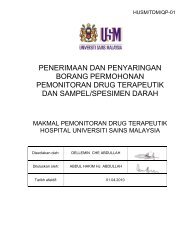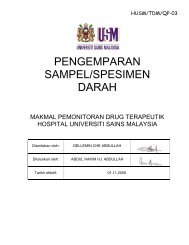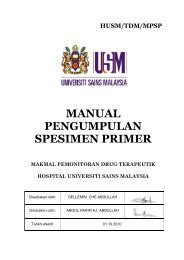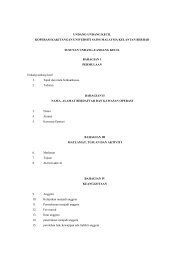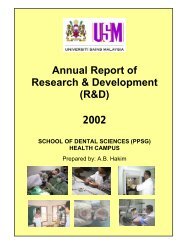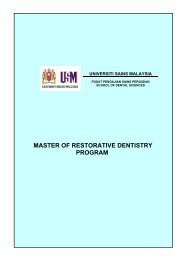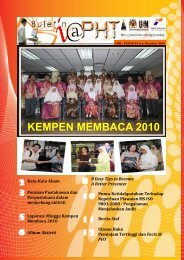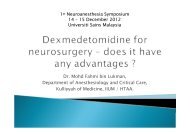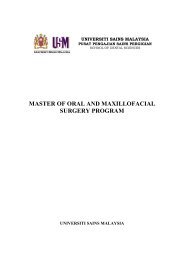Vol 11-R2- Eyelid
Vol 11-R2- Eyelid
Vol 11-R2- Eyelid
Create successful ePaper yourself
Turn your PDF publications into a flip-book with our unique Google optimized e-Paper software.
SRPS • <strong>Vol</strong>ume <strong>11</strong> • Issue <strong>R2</strong> • 2010<br />
movement of the canthal angle by its posterior<br />
fibrous attachments to the check ligament of the<br />
lateral rectus muscle. In contrast to the medial<br />
canthus, the lateral canthus is mobile, possessing<br />
up to 6 mm of vertical movement and 2 mm of<br />
lateral movement. 28,29 The lateral canthal tendon is<br />
a fibrous structure that joins the upper and lower<br />
tarsal plates to Whitnall tubercle inside the orbital<br />
rim, deep to the septum. Whitnall tubercle is an<br />
area that is not easily found intraoperatively and<br />
must be estimated clinically. It forms a prominence<br />
approximately 5 mm posterior to the lateral orbital<br />
rim. 30 Rosenstein et al. 31 described the lateral<br />
canthal tendon:<br />
“Superiorly, it is in continuity<br />
with the lateral horn of the levator<br />
aponeurosis. Inferiorly, it receives<br />
fibrous contributions from Lockwood’s<br />
suspensory ligament and then curves<br />
posteriorly to attach to Whitnall’s<br />
tubercle. Anteriorly, the lateral extensions<br />
of the preseptal and pretarsal orbicularis<br />
oculi muscles coalesce. Posteriorly,<br />
contributions from the check ligaments<br />
of the lateral rectus muscle complete the<br />
formation of the lateral canthal tendon.”<br />
The lateral canthus is located approximately 2 mm<br />
higher than the medial canthus. The measurement<br />
is the same for both sexes and does not change with<br />
increasing age. 28,32<br />
Vascular Supply of the <strong>Eyelid</strong>s<br />
The eyelids receive their vascular supply from the<br />
facial system, which is made from the branches off<br />
the internal and external carotid arteries. Off of the<br />
internal carotid artery comes the ophthalmic artery,<br />
which branches into the supraorbital, supratrochlear,<br />
dorsal nasal, and lacrimal arteries. The external<br />
carotid artery contributes the facial artery (angular<br />
artery) and superficial temporal artery (transverse<br />
facial artery, median temporal artery, and frontal<br />
and parietal branches). The arterial network of the<br />
upper eyelid is composed of anastomoses between<br />
the collateral branches of the ophthalmic artery<br />
(supraorbital artery, supratrochlear artery, and dorsal<br />
8<br />
nasal artery), a branch of the facial artery (angular<br />
artery), and the superficial temporal artery. 33,34<br />
The lateral region of the upper eyelid also receives<br />
further blood supply from the branches of the<br />
superficial temporal artery and the lacrimal artery. 34<br />
Erdogmus and Govsa 33 described the<br />
connection of the vascular supply and its location:<br />
“The dissection showed that the main<br />
blood supplies of the upper and lower<br />
lids were provided by the arterial arcades;<br />
the marginal, peripheral, superficial,<br />
and the deep ones. The marginal and<br />
peripheral arcades consisted of the<br />
anastomosis of medial and lateral<br />
palpebral arteries. The marginal arcade<br />
coursed just anterior to the lower<br />
margin of the tarsal plate and gave<br />
off small perforating branches that<br />
ascended tortuously on both sides of the<br />
orbicularis oculi muscle and the tarsal<br />
plate. These branches extend to the skin,<br />
the muscle and the tarsal plate. The<br />
perforating branches running over the<br />
orbicularis oculi traversed obliquely, in<br />
contrast to the perforating vessels, with a<br />
descending diameter and became part of<br />
the vascular plexus and lower palpebrae<br />
in all cases. The peripheral arcade coursed<br />
along the upper border of the tarsal plate.<br />
It was positioned along the surface of<br />
the Muller muscle at the superior border<br />
of the tarsus. The peripheral arcade gave<br />
off perforating branches that descended<br />
on both sides of the tarsal plate. The<br />
descending branches running over the<br />
tarsal plate connected with the ascending<br />
branches arising from the marginal<br />
arcade, whereas the descending branches<br />
coursing under the tarsal plate fanned<br />
out fine vessels and formed a vascular<br />
network with the ascending branches<br />
arising from the marginal arcade.”<br />
The authors observed arterial arcades near the<br />
orbital rim and perforating vessels running on the<br />
superficial and deep surfaces of the orbicularis oculi



